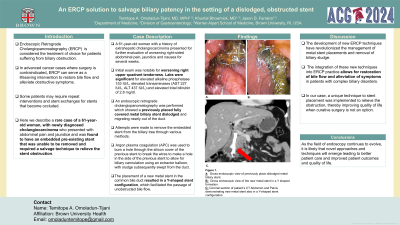Sunday Poster Session
Category: Interventional Endoscopy
P1077 - Navigating the Biliary Tree: Novel ERCP Techniques for Biliary Stent Exchange
Sunday, October 27, 2024
3:30 PM - 7:00 PM ET
Location: Exhibit Hall E

Has Audio
.jpg)
Temitope Omoladun-Tijani, MD
Brown Medicine/Lifespan
Providence, RI
Presenting Author(s)
Temitope Omoladun-Tijani, MD1, Kuntal Bhowmick, MD2, Jason Ferreira, MD1
1Brown Medicine/Lifespan, Providence, RI; 2Kaiser Permanente, Los Angeles, CA
Introduction: ERCP is the treatment of choice for patients suffering from biliary obstruction. Some patients may require repeat interventions and stent exchanges for stents that become occluded. Here we describe a rare case of a 61-year-old woman, with newly diagnosed cholangiocarcinoma who presented with abdominal pain and jaundice and was found to have an embedded pre-existing stent that was unable to be removed and required a novel technique to relieve the stent obstruction.
Case Description/Methods: A 61-year-old woman with a history of extrahepatic cholangiocarcinoma presented for further evaluation of worsening right-sided abdominal pain, jaundice and nausea for several weeks. On admission, physical exam was remarkable for worsening right upper quadrant and generalized tenderness. Lab studies significant for elevated alkaline phosphatase 153 IU/L, elevated transaminases (AST 227 IU/L, ALT 437 IU/L), elevated total bilirubin of 2.8 mg/dl and normal glucose levels. A endoscopic retrograde cholangiopancreatography was performed which showed a previously placed fully covered metal biliary stent dislodged and migrating nearly out of the duct. Attempts were made to remove the stent from the biliary tree through various methods. A rat-toothed forceps was first used but only about half of the stent could be pulled out with the other half embedded within the bile duct. Argon plasma coagulation (APC) was used to break the metal in order to cut off the portion of the stent that was protruding into the duodenum but this technique was unsuccessful. The APC was successful in creating a hole through the stent silicon covering near the ampulla through which the bile duct could be cannulated using an extractor balloon. The biliary tree was subsequently swept with an 8.5mm balloon starting at the bifurcation and sludge was swept from the duct. The placement of a new metal stent in the common bile duct resulted in a Y-shaped stent configuration, which facilitated the passage of unobstructed bile flow.
Discussion: The development of new ERCP techniques have revolutionized the management of metal stent exchange and removal of biliary sludge. The integration of these new techniques into ERCP practice allows for restoration of bile flow and alleviation of symptoms in patients with complex biliary disorders. As the field of endoscopy continues to evolve, it is likely that novel approaches, such as ours, will emerge leading to better patient care and improved patient outcomes and quality of life.
Disclosures:
Temitope Omoladun-Tijani, MD1, Kuntal Bhowmick, MD2, Jason Ferreira, MD1. P1077 - Navigating the Biliary Tree: Novel ERCP Techniques for Biliary Stent Exchange, ACG 2024 Annual Scientific Meeting Abstracts. Philadelphia, PA: American College of Gastroenterology.
1Brown Medicine/Lifespan, Providence, RI; 2Kaiser Permanente, Los Angeles, CA
Introduction: ERCP is the treatment of choice for patients suffering from biliary obstruction. Some patients may require repeat interventions and stent exchanges for stents that become occluded. Here we describe a rare case of a 61-year-old woman, with newly diagnosed cholangiocarcinoma who presented with abdominal pain and jaundice and was found to have an embedded pre-existing stent that was unable to be removed and required a novel technique to relieve the stent obstruction.
Case Description/Methods: A 61-year-old woman with a history of extrahepatic cholangiocarcinoma presented for further evaluation of worsening right-sided abdominal pain, jaundice and nausea for several weeks. On admission, physical exam was remarkable for worsening right upper quadrant and generalized tenderness. Lab studies significant for elevated alkaline phosphatase 153 IU/L, elevated transaminases (AST 227 IU/L, ALT 437 IU/L), elevated total bilirubin of 2.8 mg/dl and normal glucose levels. A endoscopic retrograde cholangiopancreatography was performed which showed a previously placed fully covered metal biliary stent dislodged and migrating nearly out of the duct. Attempts were made to remove the stent from the biliary tree through various methods. A rat-toothed forceps was first used but only about half of the stent could be pulled out with the other half embedded within the bile duct. Argon plasma coagulation (APC) was used to break the metal in order to cut off the portion of the stent that was protruding into the duodenum but this technique was unsuccessful. The APC was successful in creating a hole through the stent silicon covering near the ampulla through which the bile duct could be cannulated using an extractor balloon. The biliary tree was subsequently swept with an 8.5mm balloon starting at the bifurcation and sludge was swept from the duct. The placement of a new metal stent in the common bile duct resulted in a Y-shaped stent configuration, which facilitated the passage of unobstructed bile flow.
Discussion: The development of new ERCP techniques have revolutionized the management of metal stent exchange and removal of biliary sludge. The integration of these new techniques into ERCP practice allows for restoration of bile flow and alleviation of symptoms in patients with complex biliary disorders. As the field of endoscopy continues to evolve, it is likely that novel approaches, such as ours, will emerge leading to better patient care and improved patient outcomes and quality of life.
Disclosures:
Temitope Omoladun-Tijani indicated no relevant financial relationships.
Kuntal Bhowmick indicated no relevant financial relationships.
Jason Ferreira indicated no relevant financial relationships.
Temitope Omoladun-Tijani, MD1, Kuntal Bhowmick, MD2, Jason Ferreira, MD1. P1077 - Navigating the Biliary Tree: Novel ERCP Techniques for Biliary Stent Exchange, ACG 2024 Annual Scientific Meeting Abstracts. Philadelphia, PA: American College of Gastroenterology.
